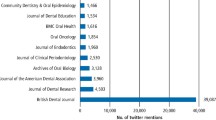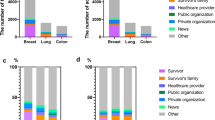Abstract
Social media services, especially Twitter, are used as a commonly sharing tool in the scientific world. This widespread use of Twitter would be an effective method in spreading academic publications. So, we aimed to investigate the relationship between Twitter mentions and traditional citations of articles in sexual medicine journals in this study. We reviewed the articles published in seven journals of sexual medicine (2 years after the publication of the articles) between January 2018 and June 2018. In the first half of 2018, 410 articles were extracted. Of these, 352 (85.9%) were original articles, while 58 (14.1%) were review articles. The median number of citations of the articles mentioned at least once on Twitter was 7 (interquartile range: 0–111) for Google Scholar, whereas it was 0 (interquartile range: 0–63) for Scopus, respectively. It was 4 (interquartile range: 0–25) for Google Scholar and 0 (interquartile range: 0–7) for Scopus. The publications mentioned on Twitter were cited more than the non-mentioned publications in the traditional-based citation system (p < 0.001). A significant relationship between the citation numbers and tweet numbers was also observed (p < 0.001). Also, in the linear regression model, the tweet numbers (p < 0.001) and article types (p < 0.001) were found to be related to the Google Scholar citation numbers. In conclusion, using Twitter as a professional tool in academic life would allow information to be propagated and responded quickly, especially for sexual medicine journals.
This is a preview of subscription content, access via your institution
Access options
Subscribe to this journal
Receive 8 print issues and online access
$259.00 per year
only $32.38 per issue
Buy this article
- Purchase on Springer Link
- Instant access to full article PDF
Prices may be subject to local taxes which are calculated during checkout


Similar content being viewed by others
References
Boyd DM, Ellison NB. Social network sites: definition, history, and scholarship. J Comput Mediat Commun. 2007;13:210–30.
Ucar T, Culpan M, Caskurlu T, Karaman Mİ, Silay MS. The activity and discussion points of# Circumcision through Twitter; a microblogging platform. Int J Impot Res. 2018;30:249–52.
Matta R, Doiron C, Leveridge MJ. The dramatic increase in social media in urology. J Urol. 2014;192:494–8.
Loeb S, Catto J, Kutikov A. Social media offers unprecedented opportunities for vibrant exchange of professional ideas across continents. Eur Urol. 2014;66:118–9.
Dol J, Tutelman PR, Chambers CT, Barwick M, Drake EK, Parker JA, et al. Health researchers’ use of social media: scoping review. J Med Internet Res. 2019;21:e13687.
Davidson PM, Newton PJ, Ferguson C, Daly J, Elliott D, Homer C, et al. Rating and ranking the role of bibliometrics and webometrics in nursing and midwifery. Sci. World J. 2014;2014:135812.
Eysenbach G. Can tweets predict citations? Metrics of social impact based on Twitter and correlation with traditional metrics of scientific impact. J Med Internet Res. 2011;13:e123.
Zahedi Z, Costas R, Wouters P. How well developed are altmetrics? A cross-disciplinary analysis of the presence of ‘alternative metrics’ in scientific publications. Scientometrics. 2014;101:1491–513.
Kwok R. Research impact: altmetrics make their mark. Nature. 2013;500:491–3.
Loeb S, Bayne CE, Frey C, Davies BJ, Averch TD, Woo HH, et al. Updated survey of social media use by members of the American Urological Association. Urol Pract. 2015;2:138–43.
Borgmann H, DeWitt S, Tsaur I, Haferkamp A, Loeb S. Novel survey disseminated through Twitter supports its utility for networking, disseminating research, advocacy, clinical practice and other professional goals. Can Urol Assoc J. 2015;9:E713–7.
Hicks D, Wouters P, Waltman L, De Rijcke S, Rafols I. Bibliometrics: the Leiden Manifesto for research metrics. Nature. 2015;520:429–31.
Elmore SA. The Altmetric attention score: what does it mean and why should I care? Toxicol Pathol. 2018;46:252–5.
Ortega JL. Reliability and accuracy of altmetric providers: a comparison among Altmetric. com, PlumX and Crossref Event Data. Scientometrics. 2018;116:2123–38.
Cooper C, Booth A, Britten N, Garside R. A comparison of results of empirical studies of supplementary search techniques and recommendations in review methodology handbooks: a methodological review. Syst Rev. 2017;6:234.
Bornmann L, Daniel HD. What do citation counts measure? A review of studies on citing behavior. J Doc. 2008;64:45–80.
Zhu X, Turney P, Lemire D, Vellino A. Measuring academic influence: not all citations are equal. J Assoc Inf Sci Technol. 2015;66:408–27.
Costas R, Zahedi Z, Wouters P. Do “altmetrics” correlate with citations? Extensive comparison of altmetric indicators with citations from a multidisciplinary perspective. J Assoc Inf Sci Technol. 2015;66:2003–19.
Warren HR, Raison N, Dasgupta P. The rise of altmetrics. J Am Med Assoc. 2017;317:131–2.
Chang J, Desai N, Gosain A. Correlation between altmetric score and citations in pediatric surgery core journals. J Surg Res. 2019;243:52–8.
Azer SA, Azer S. Top-cited articles in medical professionalism: a bibliometric analysis versus altmetric scores. BMJ Open. 2019;9:e029433.
Loeb S, Bayne CE, Frey C, Davies BJ, Averch TD, Woo HH, et al. Use of social media in urology: data from the A merican U rological A ssociation (AUA). BJU Int. 2014;113:993–8.
Fuoco M, Leveridge MJ. Early adopters or laggards? Attitudes toward and use of social media among urologists. BJU Int. 2015;115:491–7.
Ku S, Balasubramanian A, Yu J, Srivatsav A, Gondokusumo J, Tatem AJ, et al. A systematic evaluation of YouTube as an information source for male infertility. Int J Impot Res. 2020. https://doi.org/10.1038/s41443-020-0322-9 [Epub ahead of print].
R Russo GI, di Mauro M, Cocci A, Cacciamani G, Cimino S, Serefoglu EC, et al. Consulting “Dr Google” for sexual dysfunction: a contemporary worldwide trend analysis. Int J Impot Res. 2020;32:455–61.
Altintas E, Gul M. The dark side of the internet regarding sexual education. Int J Impot Res. 2021. https://doi.org/10.1038/s41443-020-00398-0 [Epub ahead of print].
George DR, Dellasega C. Use of social media in graduate-level medical humanities education: two pilot studies from Penn State College of Medicine. Med Teach. 2011;33:e429–34.
Greil-Soyka M, Quayle E, Bitzer J. European Sexual Medicine Network: a unique platform for collaboration. Int J Impot Res. 2020. https://doi.org/10.1038/s41443-020-0299-4 [Epub ahead of print].
Rivas JG, Socarras MR, Patruno G, Uvin P, Esperto F, Dinis PJ, et al. Perceived role of social media in urologic knowledge acquisition among young urologists: a European survey. Eur Urol Focus. 2018;4:768–73.
Loeb S, Carrick T, Frey C, Titus T. Increasing social media use in urology: 2017 American Urological Association Survey. Eur Urol Focus. 2020;6:605–8.
Chaudhry A, Glodé LM, Gillman M, Miller RS. Trends in Twitter use by physicians at the American Society of Clinical Oncology annual meeting, 2010 and 2011. J Oncol Pract. 2012;8:173–8.
Cochran A, Kao LS, Gusani NJ, Suliburk JW, Nwomeh BC. Use of twitter to document the 2013 academic surgical congress. J Surg Res. 2014;190:36–40.
Wilkinson SE, Basto MY, Perovic G, Lawrentschuk N, Murphy DG. The social media revolution is changing the conference experience: analytics and trends from eight international meetings. BJU Int. 2015;115:839–46.
Thangasamy IA, Leveridge M, Davies BJ, Finelli A, Stork B, Woo HH. International urology journal club via Twitter: 12-month experience. Eur Urol. 2014;66:112–7.
Darling ES, Shiffman D, Côté IM, Drew JA. The role of Twitter in the life cycle of a scientific publication. PeerJ PrePrints. 2013;1:e16v1. https://doi.org/10.7287/peerj.preprints.16v1.
Chandrasekar T, Goldberg H, Klaassen Z, Wallis CJ, Leong JY, Liem S, et al. Twitter and academic urology in the United States and Canada: a comprehensive assessment of the Twitterverse in 2019. BJU Int. 2020;125:173–81.
Kelly BS, Redmond CE, Nason GJ, Healy GM, Horgan NA, Heffernan EJ. The use of Twitter by radiology journals: an analysis of Twitter activity and impact factor. J Am Coll Radiol. 2016;13:1391–6.
Smith ZL, Chiang AL, Bowman D, Wallace MB. Longitudinal relationship between social media activity and article citations in the journal Gastrointestinal Endoscopy. Gastrointest Endosc. 2019;90:77–83.
Gast KM, Kuzon WM Jr, Waljee JF. Bibliometric indices and academic promotion within plastic surgery. Plast Reconstr Surg. 2014;134:838e–44e.
O’Kelly F, Nason G, Manecksha R, Cascio S, Quinn F, Leonard M, et al. The effect of social media (# SoMe) on journal impact factor and parental awareness in paediatric urology. J Pediatr Urol. 2017;13:513.
Hayon S, Tripathi H, Stormont IM, Dunne MM, Naslund MJ, Siddiqui MM. Twitter mentions and academic citations in the urologic literature. Urology. 2019;123:28–33.
Alsyouf M, Stokes P, Hur D, Amasyali A, Ruckle H, Hu B. ‘Fake news’ in urology: evaluating the accuracy of articles shared on social media in genitourinary malignancies. BJU Int. 2019;124:701–6.
Gul M, Diri MA. YouTube as a source of information about premature ejaculation treatment. J Sex Med. 2019;16:1734–40.
Baunacke M, Groeben C, Borgmann H, Salem J, Kliesch S, Huber J. Andrology on the Internet: most wanted, controversial and often primary source of information for patients. Andrologia. 2018;50:e12877.
Zattoni F, Gül M, Soligo M, Morlacco A, Motterle G, Collavino J, et al. The impact of COVID-19 pandemic on pornography habits: a global analysis of Google Trends. Int J Impot Res. 2020;28:1–8.
Author information
Authors and Affiliations
Corresponding author
Ethics declarations
Competing interests
The authors declare no competing interests.
Additional information
Publisher’s note Springer Nature remains neutral with regard to jurisdictional claims in published maps and institutional affiliations.
Rights and permissions
About this article
Cite this article
Ozkent, M.S., Böcü, K., Altintas, E. et al. Correlation between Twitter mentions and academic citations in sexual medicine journals. Int J Impot Res 34, 593–598 (2022). https://doi.org/10.1038/s41443-021-00457-0
Received:
Revised:
Accepted:
Published:
Issue Date:
DOI: https://doi.org/10.1038/s41443-021-00457-0
This article is cited by
-
Testicular pain and youtube™: are uploaded videos a reliable source to get information?
International Journal of Impotence Research (2023)



